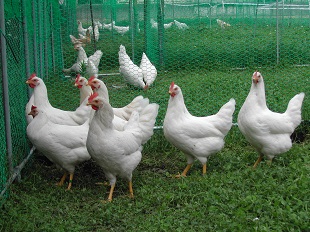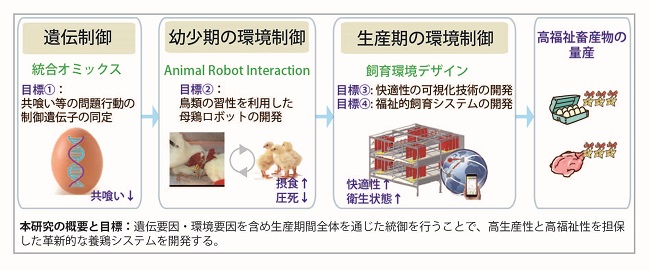動物の行動や情動の理解と制御

メンバー: 新村毅
分野: 動物生命科学、ゲノム科学、農業工学
所属: 農学研究院
キーワード: 動物行動学、アニマルウェルフェア、畜産IoT、Animal Computer Interaction
ウェブサイト:
研究概要
家畜福祉(アニマルウェルフェア)とは、家畜の快適性を確保することで、生産性を向上させ、さらに安全で人類の健康に寄与する高付加価値の畜産物を生み出すものです。私達は、言葉を話すことができない動物の心や欲求を、その行動を通して判断し、それを家畜生産技術にフィードバックすることにより、動物と管理者の双方にとってよりよい環境づくり(One Welfare)を目指しています。
現在、私達のグループでは、サイエンスとしての面白さと応用性を兼ね備えた研究を目指し、①システム行動生物学と②Animal Computer Interactionを2つの大きな柱として研究を進めています。動物の行動を軸としつつ、目標を達成するために、必要なあらゆる技術を投入することを特色としています。
①システム行動生物学
システム行動生物学の目指すところは、システム生物学を行動学に取り入れ、行動の分子メカニズムを理解して制御することにあります。現在、共喰いや発声等の行動に焦点を置き、ゲノムレベルから生態レベルまでを扱う統合オミックスを軸にして、制御遺伝子の同定に取り組んでいます。
②Animal Computer Interaction
Animal Computer Interactionの目指すところは、ヒトが携帯と会話するSiriのように、動物との会話を実現することにあります。現在、動物行動学・情報工学・ロボット工学の融合により、音声コミュニケーションや行動から、動物の情動を可視化して制御する技術開発に取り組んでいます。

主要論文・参考事項
- Nakayama & Shimmura et al. Nature Ecology & Evolution 3, 845–852 (2019).
DOI: 10.1038/s41559-019-0866-6 - Shimmura et al. Scientific Reports 9, 3978 (2019).
DOI: 10.1038/s41598-019-40746-9 - Shimmura et al. Nature Communications 8, 412 (2017).
DOI: 10.1038/s41467-017-00432-8 - Shimmura et al. Scientific Reports 5, 11683 (2015).
DOI: 10.1038/srep11683 - Nakane & Shimmura et al. Current Biology 24, R596–R597 (2014).
DOI: 10.1016/j.cub.2014.05.038 - Shimmura & Yoshimura. Current Biology 23, R231-R233 (2013).
DOI: 10.1016/j.cub.2013.02.015
お問い合わせ先
東京農工大学・先端産学連携研究推進センター
urac[at]ml.tuat.ac.jp([at]を@に変換してください)
Understanding and regulating of animal behaviour and emotion

Research members: Dr. Tsuyoshi Shimmura
Research fields: Animal life science, Genome science, Agro-engineering
Departments: Department of Agriculture
Keywords: Animal Behaviour, Animal Welfare, IoT, Animal Science, Animal Computer Interaction
Web site:
Summary
Through ensuring the comfort of animals, animal welfare is intended to improve productivity as well as to create safe, high-added-value animal products that can contribute to human health. Since the 21st century, animal welfare has become a global standard, and this change has resulted in an obvious frame shift in livestock management systems. While carrying out these basic and applied research studies in parallel, I learned a host of techniques for understanding the multiple layers behind animal behavior, from the ecological to the molecular. Most animals communicate using innate vocalization, which does not require learning. However, the control mechanism behind innate vocalization has yet to be elucidated in any organism.
I use the rooster’s crowing "cock-a-doodle-doo" as a model, and to date, I have found that the timing of crowing in roosters is controlled by a circadian clock and social rank. Also I have been uncovering the molecular mechanism on pattern and motivation of vocalization. My research initiative is aimed at understanding the vocal communications of animals by quantifying them automatically using technolgies and informatics. Then I intend to work on human regulation of the communications using sound stimilus. I also intend to work on the molecular mechanism of cannibalism and then on generating a chicken strain in which cannibalism is genetically regulated.
These experiments would bear fruit in the form of revolutionary management systems for controlling animal behavior, achieved by regulating genetic and environmental factors and their interaction (i.e. epigenetic factors). The achievements resulting from this research initiative could improve productivity both in quantitative and qualitative terms. It is my hope that my proposed research initiative will serve as a foundation for building a sustainable society wherein humans and animals can coexist.
Reference articles and patents
- Nakayama & Shimmura et al. Nature Ecology & Evolution 3, 845–852 (2019).
DOI: 10.1038/s41559-019-0866-6 - Shimmura et al. Scientific Reports 9, 3978 (2019).
DOI: 10.1038/s41598-019-40746-9 - Shimmura et al. Nature Communications 8, 412 (2017).
DOI: 10.1038/s41467-017-00432-8 - Shimmura et al. Scientific Reports 5, 11683 (2015).
DOI: 10.1038/srep11683 - Nakane & Shimmura et al. Current Biology 24, R596–R597 (2014).
DOI: 10.1016/j.cub.2014.05.038 - Shimmura & Yoshimura. Current Biology 23, R231-R233 (2013).
DOI: 10.1016/j.cub.2013.02.015
Contact
University Research Administration Center (URAC),
Tokyo University of Agriculture and Technology
urac[at]ml.tuat.ac.jp
(Please replace [at] with @.)

